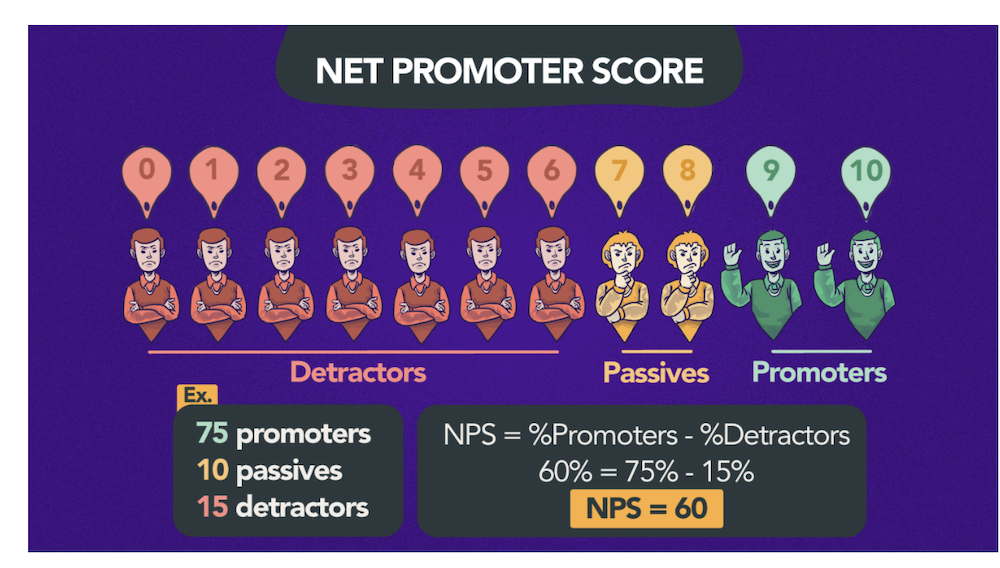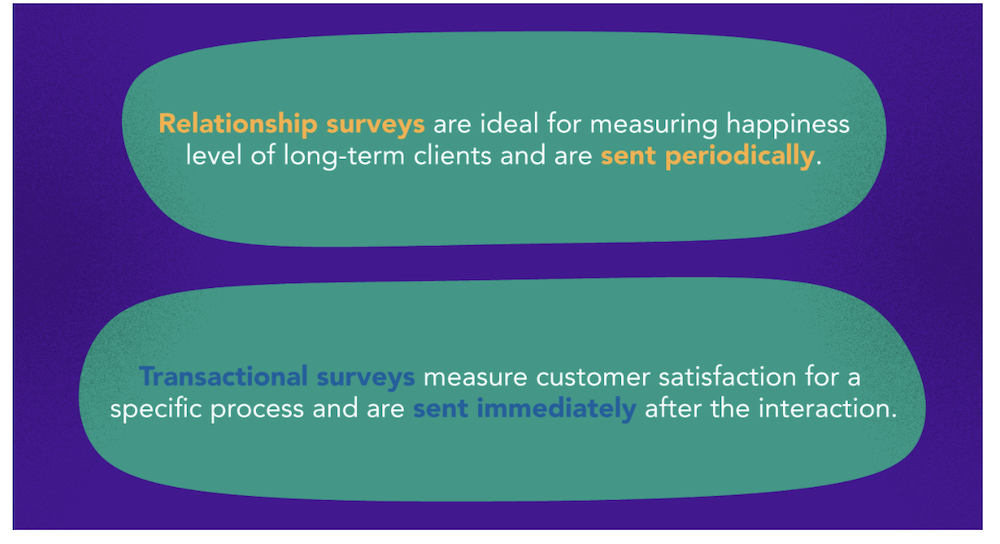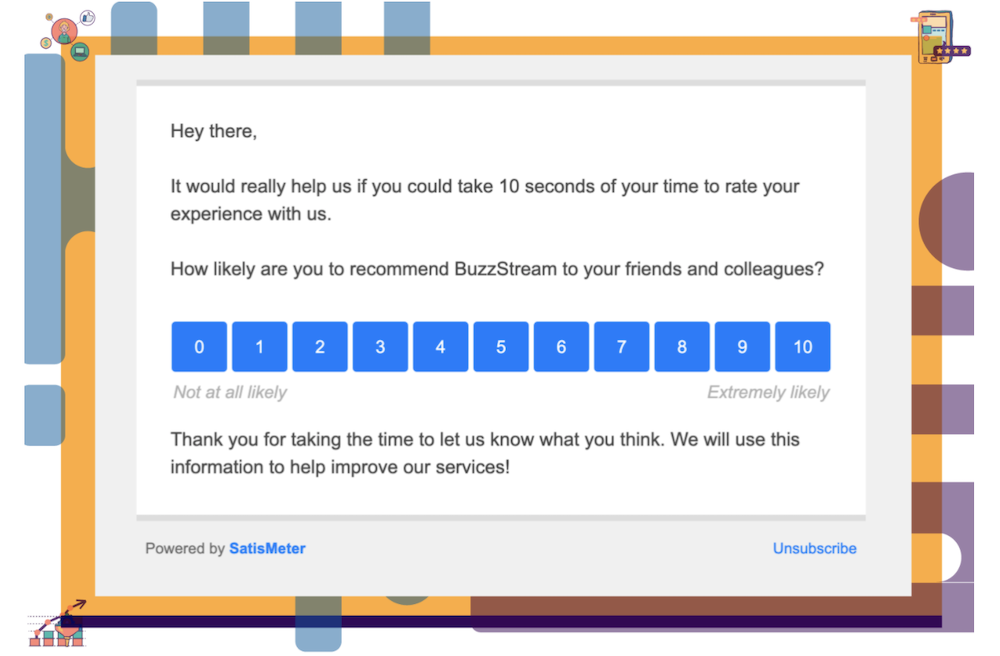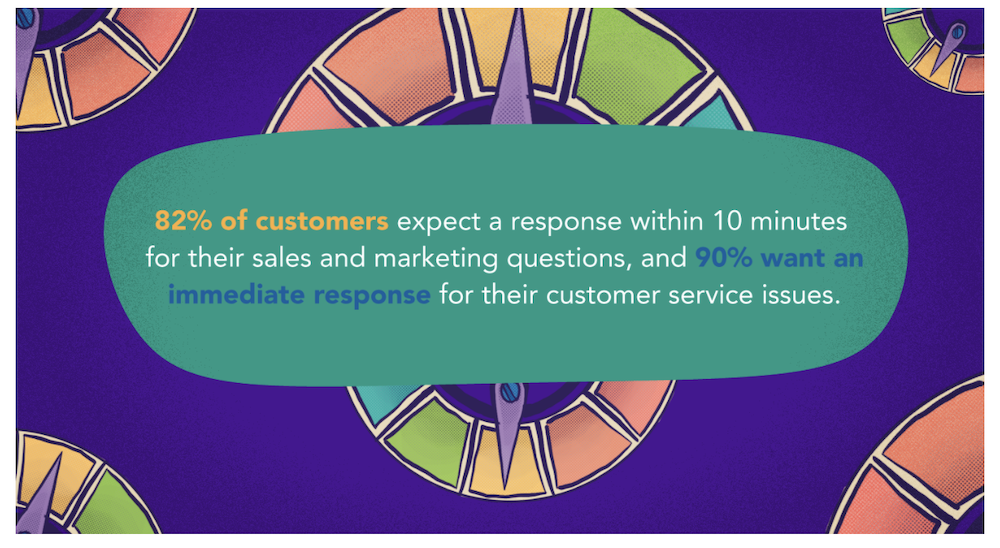What do your customers really think of you? They may like your products or services, but are they willing to put their support behind them?
That’s where Net Promoter Score, or NPS, comes in. Net Promoter Score is a metric that measures how likely customers are to recommend your company to a friend, family member, or colleague.
NPS is an excellent way to evaluate your current customer experience strategy and business as a whole.
But what is Net Promoter Score, how do you calculate it, and what can you do to improve it?
Read on to find out.
Table of Contents
- What Is Net Promoter Score (NPS?)
- Why Is NPS Important?
- What Is The Net Promoter Score Formula?
- How To Collect And Calculate NPS Data From Customers
- How To Interpret Net Promoter Scores
- How To Improve Your Net Promoter Score
- Business Software For Customer Surveys
What Is Net Promoter Score (NPS)?
Net Promoter Score (NPS) is a metric that asks current customers to rate a company’s overall performance on a scale from 0 to 10. The score is determined by the answer to only one question: “How likely are you to recommend us to a friend or colleague?”
NPS aggregates the ratings from multiple customers and determines a score for companies to gauge customer satisfaction levels with everything from individual agent skills and product performance to customer segments and overall company impressions.
NPS may seem simple on the surface.
However, it’s actually a complex metric that helps companies understand brand perception, organizational performance, customer experience, growth potential, and customer satisfaction.
When used and analyzed correctly, the net promoter score helps companies build strong customer relationships and increase customer retention. This is a boon for profits, given just a 5% increase in retention can lead to a rise in profit of more than 25%.
Why Is Net Promoter Score Important?
Net Promoter Score is important because it offers insight into how customers perceive your company.
A high NPS indicates a successful business with satisfied, happy customers and skilled representatives. A low NPS shows the opposite, indicating a need for improvement.
According to Bain & Co., who created the metric, Net Promoter Score accounts for 20% to 60% of a company’s organic growth rate. The company also reports industry leaders typically have an NPS of more than double their competitors.
What Is the Net Promoter Score Formula?
The Net Promoter Score Formula is:
Net Promoter Score =
(Number of Promoters/Total Number of Respondents) x 100 – (Number of Detractors/Total Number of Respondents) x 100

Now, let’s take a look at some specific Net Promoter Score calculations.

The below step-by-step guide shows you how to calculate the NPS formula using fictitious numbers.
Company A surveyed 100 customers, which yielded the following results:
- 75 promoters
- 10 passives
- 15 detractors
When we apply the net promoter score (NPS) formula, we get:
%Promoters – %Detractors = NPS
75% – 15% = 60%
Thus, NPS would be 60.
Of course, the formula only makes sense if you understand how to get customers to answer the all-important NPS question, what different customer response categories mean, and how corresponding customer personas are assigned.
How To Collect And Calculate NPS Data
When done correctly, NPS makes it much easier for companies to have a grasp on who their customers are and what they want.
Now, let’s take a look at the step-by-step instructions businesses need to follow in order to gather and accurately interpret customer data.
Step 1: Develop And Distribute Customer Surveys
The first step in calculating the NPS score is to use customer surveys to collect as many answers as possible to the central NPS question:
“How likely are you to recommend our company to a friend, family member, or colleague?”
The question should be followed by a scale of 0 to 10.
Respondents select the number of their choice—0 being unlikely to recommend, and 10 being most likely to recommend.
There are two main types of NPS surveys to send out: Relationship surveys and Transactional surveys.
Both help to measure customer loyalty and convert detractors into promoters (more on detractors and promoters later.)

Relationship Surveys
Relationship surveys are offered to regular, long-term customers on a routine basis (biannually, every business quarter, etc.)
They are used to assess customer happiness and satisfaction levels.
They also help businesses:
- Determining the likelihood customers will recommend your business to others
- Prevent customers from switching to a competitor
- Assess customer retention rates and estimate repeat purchase probabilities
Transactional Surveys
Transactional surveys offer immediate insight by measuring a customer’s current level of satisfaction with a specific interaction, process, or touchpoint.
Transactional surveys do not seek to measure overall loyalty.
Instead, they evaluate a current customer’s satisfaction level and opinion of common business transactions like order placement, customer assistance, or billing.
How And When To Send Surveys
Timing is everything when it comes to collecting valuable customer feedback.
Surveys – especially transactional ones – should be sent directly after an interaction with your brand.
These surveys can be sent via email, via a pop-up notification on your business website, live chat, or even posted or sent via messenger on social media platforms. (If you’re having trouble collecting responses, consider incentivizing customers with a discount code or giveaway entry for completing the survey.)
A sample NPS customer survey is shown below:

Step 2: Review Responses and Identify Customer Persona Categories
As we’ve stated, NPS is calculated only according to customer responses to the key question, “How likely are you to recommend our company to a friend or coworker?”
Based on their NPS responses, customers are categorized into three main groups, called “customer personas.”
They are:
- Promoters
- Passives
- Detractors
Let’s take a look at what defines each customer persona below.
Promoters
Promoters are a company’s most enthusiastic supporters – in other words, your biggest fans.
They give scores of 9 and 10 on the NPS survey.
These promoters are broken down further into four subcategories:
- Admirers: Give quantitative, but not qualitative, feedback
- Loyalists: Offer both negative and positive feedback that helps you improve your business
- Fans: Spread the word about your company and bring in referrals/new customers
- Followers: Stick around through thick and thin, your true promoters
Promoters help drive company growth, boost brand reputation, and act as brand ambassadors. They may talk about your business on social media, share their opinions with friends, family, and colleagues, or by leaving positive feedback and reviews.
Passives
Passives are on the fence about your business, not entirely happy nor unhappy with your product or service.
They generally give scores of 7 or 8 on the NPS survey.
Passives are somewhat satisfied with what you have to offer, but they’re not especially loyal and may consider switching over to the competition. They won’t go out of their way to share positive or negative feedback about their experience with your company.
It’s worth noting that, although passives are not included in the formula, their opinions are essential. This is especially true for those who rated you an 8, as they’re on the verge of being classified as promoters.
If you can identify what’s keeping them on the fence and make said improvements, you can easily convert them into promoters. If not, you’ll likely lose their business to your competitors.
Detractors
Detractors are unhappy and dissatisfied with their experience with a company.
They give NPS survey scores ranging from 0 to 6.
Detractors are the biggest threat to a company’s brand reputation and customer service metrics. Considering that dissatisfied people usually tell between 9 and 15—and sometimes up to 20—people about their bad experience, detractors can do real damage to your business.
One of your primary goals should be to ensure you have as few detractors as possible.
Step 3: Determine The Percentage Of Promoters And Detractors
Next, it’s time to determine the percentage of promoters and detractors.
Start by counting the number of people who gave you a 9 and 10 – your promoters. Then, divide the number of promoters by the total number of respondents.
In our earlier example, 75 out of 100 total respondents rated Company A a 9 or 10.
75/100 respondents means 75% of respondents are promoters.
Do the same calculation with your detractors, i.e., the people that gave you a score of 0 through 6.
In our example, 15 people gave Company A a poor score. 15/100 means 15% of survey respondents are detractors.
Step 4: Calculate Net Promoter Score
The last step is to calculate the actual NPS by subtracting the percentage of detractors from the percentage of promoters.
Using the data from our example:
75% promoters – 15% detractors = 60 NPS
The final score is expressed as a number and not a percentage, meaning Company A’s NPS is 60.
How to Interpret Net Promoter Score
The Net Promoter Score provides businesses with insight into several critical questions, such as:
- Are your customers happy with your product or service?
- How are your customers’ opinions shifting over time?
- What changes need to be made to keep your customers satisfied?
To get the most out of NPS data, companies need to know not only how to interpret customer responses, but also how to create actionable steps for improvement out of them.
What Is A Good Net Promoter Score?
A “good” NPS score varies wildly according to the business sector, but a score of 60 and above (NPS scores range from -100 to +100) is considered “very good” in any industry.
If your current score is below 60, don’t panic just yet.
How your firm’s NPS score compares to the scores of your competitors is actually more important than the raw overall score.
In other words?
While a score of 60+ definitely means your business has developed a strong customer experience strategy, scores under 60 aren’t cause for immediate concern as long as your scores are higher than your competitors’.
What Is A Bad Net Promoter Score?
Just as a “good” NPS score is relative to the competition, so is a bad score. However, many industries see any negative number as bad. That shows a company has more detractors and a lack of customer loyalty than promoters.
How Are Customer Opinions Shifting Over Time?
NPS also provides insight into the ways customers' opinions change over time.

That’s why it’s important to continually survey customers and recalculate your NPS accordingly.
Rising scores indicate happier customers while falling scores – or even an increase in Passive customer personas – indicate an issue and a need for further investigation.
Keep an eye out for repeated comments or concerns, and work from there even if the issue seems small. It’s best to be proactive before an issue spins out of control.
Determine What Changes Need to be Made
Figuring out what changes your business needs to make to improve NPS takes time and effort.
It requires reading, sorting, analyzing, and responding to feedback across all communication channels.
Identifying patterns in customer feedback help businesses understand how they can improve customer service and customer support, brand perception, first contact resolution rates, current products, and more. the customer experience, current products, and company policies.
Putting these positive changes in place will ideally not only turn more people into promoters but, equally important, maintain current promoters. Promoter retention matters especially because loyal customers spend 67% more than new ones.
How to Improve Your Net Promoter Score
Below, we’ll cover the most effective and easy-to-implement ways for businesses to improve their Net Promoter Score.
1. Establish NPS Objectives for Every Department
Customer experience involves every department, so it’s important to ensure everyone is on board with not only the overall NPS improvement strategy.
It’s equally important that each individual department or team has its own specific, targeted NPS objectives.
2. Engage With Detractors and Passives
Detractors are a vital part of the equation, sharing brutally honest reviews and opinions about your business.
They’re the best ones to identify company loopholes and shortcomings, allowing you to fix them.
The best way to remedy any situation is to engage with detractors – especially after they give you a bad score.
Following up with them ensures detractors know you’re listening, are open to feedback, and that you take their concerns seriously. Bring the issues detractors to discuss with you to internal teams that can help implement detractor feedback.
When it comes to passives, it’s best to follow a two-pronged strategy.
Reach out to those that didn’t leave an explanation for their ratings, and ask for more information. Treat passives who left feedback as detractors, and act as detailed above.
It’s also worth mentioning non-respondents here.
This critical – yet often ignored – customer segment is likely to churn. If you have any highly valuable customers in that group, get on the phone with them for a one-on-one call to find out how you can help them and what they think you should do differently.
3. Take Care Of Your Employees
Employee engagement directly impacts every aspect of business – including NPS.
Engaged employees are more productive, driven, and provide better customer service. Plus, they are loyal to their companies, decreasing costly employee churn and turnover rates.
In short, when your staff is emotionally invested in their work, they perform better.
Make sure employees feel valued through recognition programs, promotion from within, gamification, and being open to feedback.
4. Quickly Follow Up With Customers
Today’s customers want to see results ASAP.
In fact, our post on Average Handle Time shows about 90% of customers expect a response within 10 minutes for their sales and marketing questions, and 90% want an immediate response when they have a customer service issue.
This is why first-call resolution rates and other call center metrics are of utmost importance.

Once customers have provided feedback of any kind, respond and confirm that you’ve received that feedback. (Auto-responses are ideal here.)
This instant acknowledgment creates a quick improvement in a customer’s perception of your business. Acknowledging that you are listening and working on the issue shows you value your customers, which has a significant impact on your NPS.
5. Create Buyer Personas and Case Studies
In addition to categorizing customers using the three NPS personas, create more detailed, industry-specific buyer personas.
This helps you learn exactly why your promoters love you and why they chose your brand over your competitors.
Determine what you did right with your promoters, and turn your findings into a case study your colleagues and prospects can use in the future.
For example, was the customer thanked after an interaction? Did they receive a follow-up call after they made a complaint? Did they use tools like automated website chatbots to inform buying decisions? The goal is to create a highly detailed case study to replicate that satisfaction level, enhance the customer experience, and increase your NPS across the board.
6. Ask the Right Questions
Asking the right questions at the right time is key to better understanding your customers and what they want/expect from your business.
In addition to the main NPS question, ask specific questions that are relevant to your products/services and that provide more insight into who your customers are as people.
Sample survey questions could include:
- How did you find out about our company?
- What competitors did you consider buying from before you chose us?
- What is the most important thing to you when making a purchase? (Cost, Shipping Speed, Good Online Reviews, Product Features, etc.)
- What made you choose us over a competitor?
- Was it easy for you to find the product/service you needed?
- Did you receive adequate customer service when making your purchase?
Draw on data from your web analytics like their time spent on a product page, page load speed, referral URL, the number of pages viewed, etc. This will also provide insight into the customer journey and experience.
The more data you collect, and the more specific the feedback you get is, the more you can improve the NPS.
Customer Survey Tools and Applications
It’s clear that the Net Promoter Score is a critical KPI that not only measures customer loyalty and retention but also allows companies to determine what is and isn’t working for them.
The survey tools listed in the table below help you to speed up and get the most out of the NPS survey process.
| Available Survey Types | Pricing | Top Feature | |
| Survey Sparrow | - NPS, White-label surveys, automated pulse surveys, smart surveys, offline surveys, 360 assessment surveys | -1 free plan
-3 paid plans from $99 to $299 per month. Enterprise plan pricing available through direct quote. |
Customer journey map |
| Survey Monkey | -NPS, customer satisfaction, customer loyalty, events, HR, market research, opinion polls, concept testing | -3 paid plans from $25 to $75 per month. Enterprise plan pricing available through direct quote. | Additional analytics tools for NPS surveys |
| Customer Thermometer | -NPS, more than 50 integrations, tablet surveys, iOS app, Outlook signature, Salesforce satisfaction, ServiceNow satisfaction | 4 Paid Plans from $29 a month to $159 per month. | Updates NPS results in real-time |
| Zoho Survey | - Over 250 survey templates including NPS, Star Rating, Multiple Choice, and Ranking-based surveys
- Customizable survey builder tools |
- 1 Free Plan
- 3 Paid Plans from $25.00/month to $75.00/month |
Updates NPS results in real-time |
In addition to the above standalone tools, note that automated surveys are a standard feature of contact center software.
To learn more about what top platforms like Five9, Talkdesk, and Dialpad have to offer in terms of customer surveys and other features, check out top call center software vendors.



